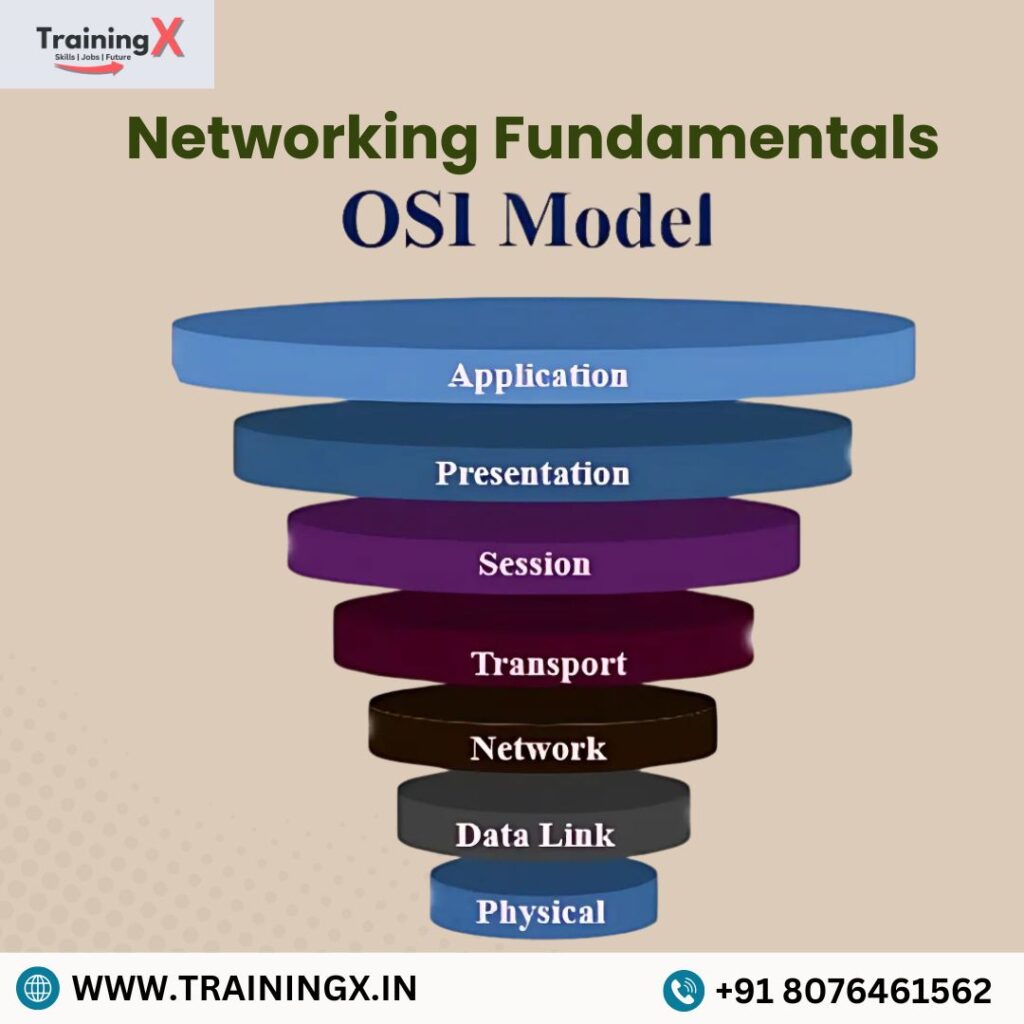You’ve worked hard to get your CCNA certification, but now comes the real challenge—the job interview! Unfortunately, many candidates struggle with tricky networking questions, practical troubleshooting scenarios, and difficulty answering confidently. More importantly, one of the biggest problems is not knowing which CCNA interview questions will be asked, how your answers should be structured effectively, or how you can be distinguished from other candidates. To overcome this, TrainingX has compiled a handpicked list of CCNA interview questions and expert answers, covering everything from basic networking principles to complex real-world scenarios. Therefore, don’t let interview anxiety hold you back—master these questions and land your dream networking job!
Section: Networking Fundamentals

Q1: What are the seven layers of the OSI model?
Ans:
- Physical Layer
- Data Link Layer
- Network Layer
- Transport Layer
- Session Layer
- Presentation Layer
- Application Layer
Q2: How does TCP differ from UDP?
Ans: On the other hand, TCP is connection-oriented and reliable, and in addition, it ensures error checking, making it slower but accurate. Conversely, UDP is connectionless, faster, with minimal overhead, and as a result, it works best for real-time applications like streaming, VoIP, and gaming. Ultimately, the choice between TCP and UDP depends on the specific requirements of the application.
Q3: What are private and public IP addresses?
- A private IP address functions within a local network (LAN) and does not have access to the internet. Network administrators assign it to devices like computers, printers, and routers to enable internal communication.
- A Public IP address is globally unique and assigned by ISPs (Internet Service Providers) to enable direct communication over the internet. It allows devices to be reachable from outside networks.
Section: IP Addressing & Subnetting
Q4: What is IP Addressing?
Ans: IP addressing is a method of assigning unique numerical labels to devices in a network to facilitate communication.
Q5: What is Subnetting?
Ans: Subnetting divides a large network into smaller subnetworks (subnets) to improve efficiency, security, and network management. It helps reduce network congestion and optimizes IP address usage.
Q6: How do you calculate subnet masks?
Ans: A subnet mask determines the network and host portions of an IP address. The calculation depends on the number of subnet bits required. Their formula to calculate subnet masks is.
- Number of Subnets:
2n2^n2n
(Where n is the number of borrowed host bits for subnetting.)
- Number of Usable Hosts per Subnet:
2h−22^h – 22h−2
(Where h is the number of host bits, and we subtract 2 for network and broadcast addresses.)
- Subnet Block Size (Increment):
256−Subnet Mask’s Last Octet
(Determines the range of each subnet.
Q7: What is CIDR, and why is it used?
Ans: CIDR (Classless Inter-Domain Routing) is a method of IP address allocation and routing that improves efficiency by removing traditional class-based address constraints (Class A, B, C). CIDR is widely used in modern networking and the internet to manage IPv4 address exhaustion efficiently.
Q8: What is CIDR, and why is it used?
Ans: Although IPv4 and IPv6 are both Internet Protocols, they differ mainly in address format, size, and functionality.
- Specifically, IPv4 is a 32-bit address system (e.g., 192.168.1.1) with around 4.3 billion addresses.
- In comparison, IPv6 is a 128-bit address system (e.g., 2001:db8::1) with almost unlimited addresses.
- Moreover, IPv6 has built-in security (IPSec), no need for NAT, and supports better routing and performance with multicast instead of broadcast.
Section: Routing & Switching
Q9: What is Routing?
Ans: In contrast to switching, routing is the process of directing data packets from one network to another using a router. Moreover, it determines the best path for data transmission. Furthermore, it helps devices communicate across different networks, like sending an email or accessing a website. As a result, routing is essential for efficient data transfer. Ultimately, it ensures seamless connectivity between networks.
Q10: What is Switching?
Ans: In simple terms, switching is the process of directing data from one device to another within a network using a switch. To begin with, it ensures efficient data transfer. Furthermore, switching is commonly used in LANs (Local Area Networks) to enable fast and reliable communication between computers, servers, and other network devices. In addition, it helps reduce network congestion. As a result, switching improves overall network performance.
Q11: Explain the purpose of VLANs and how they work?
Ans: A VLAN (Virtual Local Area Network) is used to logically segment a network into smaller groups, thereby improving security, performance, and manageability. Moreover, it helps reduce broadcast traffic, which in turn enhances network efficiency. Additionally, VLANs prevent unauthorized access, making them a crucial security feature.
Q12: How do VLANs Work?
Ans:
- A switch assigns devices to VLANs based on port number, MAC address, or protocol.
- Devices in the same VLAN communicate seamlessly, just like they are on the same physical network. Furthermore, this allows for efficient data exchange. Additionally, they can do so even if they are in different locations. As a result, VLANs enhance network flexibility and scalability.
- Traffic between VLANs requires a router or Layer 3 switch (Inter-VLAN Routing).
- VLANs help create efficient, organized, and secure network structures in enterprises.
Section: Network Security
Q13: What is Network Security?
Ans: Network security refers to the practices, technologies, and policies used to protect a network from unauthorized access, cyber threats, and data breaches.
Q14: What are the essential network security measures, and why are they important?
Ans: Here are the key security measures and their importance:
- Firewalls – Block unauthorized traffic.
- Antivirus & Anti-malware – Protect against malicious software.
- Encryption – Secures data transmission.
- Access Control – Restricts unauthorized users.
- Intrusion Detection & Prevention (IDS/IPS) – Monitors and blocks threats.
Q15: How does NAT (Network Address Translation) function?
Ans: Network Address Translation (NAT) is a technique specifically used to map private IP addresses to public IP addresses before data is sent over the Internet. Moreover, it allows multiple devices in a local network to share a single public IP address, thus conserving IPv4 addresses and ultimately improving security. As a result, NAT plays a crucial role in modern networking.
Conclusion
Cracking a CCNA interview requires more than just certification—rather, it demands a strong grasp of networking concepts, troubleshooting skills, and confidence in real-world scenarios. After all, employers seek candidates who can explain routing, switching, VLANs, subnetting, and security with clarity. Therefore, at TrainingX, a leading CCNA Institute in Delhi, we provide hands-on expertise, expert-led training, and interview strategies to help you stand out in the competitive IT job market. Whether you’re a fresher or an experienced professional, our training not only boosts confidence but also sharpens skills and increases your chances of success.
